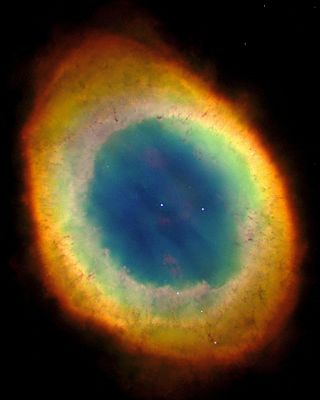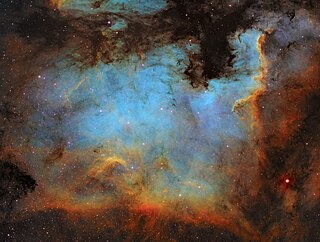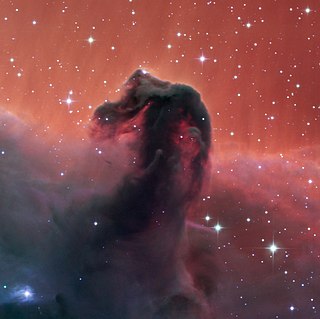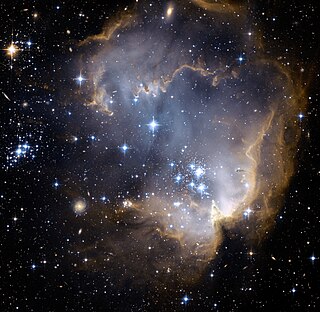
A nebula is a distinct luminescent part of interstellar medium, which can consist of ionized, neutral, or molecular hydrogen and also cosmic dust. Nebulae are often star-forming regions, such as in the Pillars of Creation in the Eagle Nebula. In these regions, the formations of gas, dust, and other materials "clump" together to form denser regions, which attract further matter and eventually become dense enough to form stars. The remaining material is then thought to form planets and other planetary system objects.

A planetary nebula is a type of emission nebula consisting of an expanding, glowing shell of ionized gas ejected from red giant stars late in their lives.

An emission nebula is a nebula formed of ionized gases that emit light of various wavelengths. The most common source of ionization is high-energy ultraviolet photons emitted from a nearby hot star. Among the several different types of emission nebulae are H II regions, in which star formation is taking place and young, massive stars are the source of the ionizing photons; and planetary nebulae, in which a dying star has thrown off its outer layers, with the exposed hot core then ionizing them.

The Orion Nebula is a diffuse nebula situated in the Milky Way, being south of Orion's Belt in the constellation of Orion,[b] and is known as the middle "star" in the "sword" of Orion. It is one of the brightest nebulae and is visible to the naked eye in the night sky with an apparent magnitude of 4.0. It is 1,344 ± 20 light-years (412.1 ± 6.1 pc) away and is the closest region of massive star formation to Earth. The M42 nebula is estimated to be 24 light-years across. It has a mass of about 2,000 times that of the Sun. Older texts frequently refer to the Orion Nebula as the Great Nebula in Orion or the Great Orion Nebula.

An H II region or HII region is a region of interstellar atomic hydrogen that is ionized. It is typically in a molecular cloud of partially ionized gas in which star formation has recently taken place, with a size ranging from one to hundreds of light years, and density from a few to about a million particles per cubic centimetre. The Orion Nebula, now known to be an H II region, was observed in 1610 by Nicolas-Claude Fabri de Peiresc by telescope, the first such object discovered.

A proplyd, short for ionized protoplanetary disk, is an externally illuminated photoevaporating protoplanetary disk around a young star. Nearly 180 proplyds have been discovered in the Orion Nebula. Images of proplyds in other star-forming regions are rare, while Orion is the only region with a large known sample due to its relative proximity to Earth.

The Tarantula Nebula is a large H II region in the Large Magellanic Cloud (LMC), forming its south-east corner.

The North America Nebula is an emission nebula in the constellation Cygnus, close to Deneb. It is named because its shape resembles North America.
Photoevaporation is the process where energetic radiation ionises gas and causes it to disperse away from the ionising source. The term is typically used in an astrophysical context where ultraviolet radiation from hot stars acts on clouds of material such as molecular clouds, protoplanetary disks, or planetary atmospheres.

The Horsehead Nebula is a small dark nebula in the constellation Orion. The nebula is located just to the south of Alnitak, the easternmost star of Orion's Belt, and is part of the much larger Orion molecular cloud complex. It appears within the southern region of the dense dust cloud known as Lynds 1630, along the edge of the much larger, active star-forming H II region called IC 434.

The Lagoon Nebula is a giant interstellar cloud in the constellation Sagittarius. It is classified as an emission nebula and has an H II region.

NGC 7027, also known as the Jewel Bug Nebula or the Magic Carpet Nebula, is a very young and dense planetary nebula located around 3,000 light-years from Earth in the constellation Cygnus. Discovered in 1878 by Édouard Stephan using the 800 mm (31 in) reflector at Marseille Observatory, it is one of the smallest planetary nebulae and by far the most extensively studied.

The Orion molecular cloud complex is a star-forming region with stellar ages ranging up to 12 Myr. Two giant molecular clouds are a part of it, Orion A and Orion B. The stars currently forming within the complex are located within these clouds. A number of other somewhat older stars no longer associated with the molecular gas are also part of the complex, most notably the Orion's Belt, as well as the dispersed population north of it. Near the head of Orion there is also a population of young stars that is centered on Meissa. The complex is between 1 000 and 1 400 light-years away, and hundreds of light-years across.

NGC 2023 is an emission and reflection nebula in the equatorial constellation of Orion. It was discovered by the German-born astronomer William Herschel on 6 January 1785. This reflection nebula is one of the largest in the sky, with a size of 10 × 10 arcminutes. It is located at a distance of 1,300 ly (400 pc) from the Sun, and is positioned ~15′ to the northeast of the Horsehead Nebula.

NGC 602 is a young, bright open cluster of stars located in the Small Magellanic Cloud (SMC), a satellite galaxy to the Milky Way. It was discovered on 1 August 1826 by Scottish astronomer James Dunlop. It is embedded in a nebula known as N90.

NGC 2261 is a variable nebula located in the constellation Monoceros. The nebula is illuminated by the star R Monocerotis, which is not directly visible itself.

Sh 2-185 is an H II region centered on the massive star system Gamma Cassiopeiae in the northern constellation of Cassiopeia. It was included in the second Catalogue of H II Regions, published in 1959 by Stewart Sharpless. Sh 2-185 is located at a distance of approximately 10,500 ly (3.23 kpc) from the Sun. The region is surrounded by a dust shell, and displays several infrared point sources that are a characteristics of young stellar objects.

Proplyd 114-426 is a large protoplanetary disk seen in absorption in front of the emission of the Orion Nebula. It is one of the largest protoplanetary disks in the Orion Nebula with a diameter of 950 AU.





















